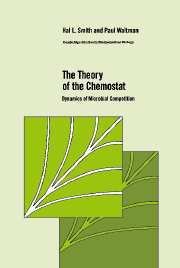Book contents
- Frontmatter
- Contents
- Preface
- 1 The Simple Chemostat
- 2 The General Chemostat
- 3 Competition on Three Trophic Levels
- 4 The Chemostat with an Inhibitor
- 5 The Simple Gradostat
- 6 The General Gradostat
- 7 The Chemostat with Periodic Washout Rate
- 8 Variable-Yield Models
- 9 A Size-Structured Competition Model
- 10 New Directions
- 11 Open Questions
- Appendices
- References
- Author index
- Subject index
4 - The Chemostat with an Inhibitor
Published online by Cambridge University Press: 07 December 2009
- Frontmatter
- Contents
- Preface
- 1 The Simple Chemostat
- 2 The General Chemostat
- 3 Competition on Three Trophic Levels
- 4 The Chemostat with an Inhibitor
- 5 The Simple Gradostat
- 6 The General Gradostat
- 7 The Chemostat with Periodic Washout Rate
- 8 Variable-Yield Models
- 9 A Size-Structured Competition Model
- 10 New Directions
- 11 Open Questions
- Appendices
- References
- Author index
- Subject index
Summary
Introduction
In the first two chapters the general theory of the chemostat was developed, and it was shown that competitive exclusion is the expected outcome. In Chapter 3, coexistence was shown to occur when the competition was at a higher trophic level; the mechanism was simply the oscillation of the object of the competition – the prey in the case being considered. In this chapter, we return to the basic chemostat model but add another factor, the presence of an inhibitor. The inhibitor affects the nutrient uptake rate of one of the competitors but is taken up by the other without ill effect. The use of Nalidixic acid in the experiments of Hansen and Hubbell [HH], discussed in Chapter 1, is an example. Its effect on one strain of E. coli was essentially nil while the growth rate of the other was severely diminished.
The interest in this subject goes far beyond laboratory examples. It is common for one strain of bacteria to be affected by an antibiotic while another is resistant. The antibiotic acts as the inhibitor in our discussion, and we want to know whether the resistant strain will eliminate the nonresistant strain. If it can, the antibiotic will not be effective in treating the disease. In commercial applications, genetically altered organisms are used to generate “products”.
- Type
- Chapter
- Information
- The Theory of the ChemostatDynamics of Microbial Competition, pp. 78 - 100Publisher: Cambridge University PressPrint publication year: 1995

